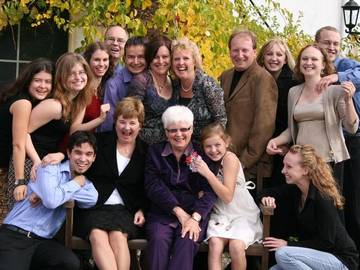Ah, family. We know who some of them are—hi, Mom and Dad, Sis and Bro, Aunt Kimmie and Uncle Kyle, Cousin Sue, Cousin Sal.
Sometimes, though, you meet someone you're supposedly related to, but neither of you really knows quite what the relationship is. You stand around speculating on just who you are to one another and throw terms around: third cousin?, second cousin once removed?, step-half-grand-aunt?

Half of these people just met today.
Let's start with the first generally well-known circle beyond the nuclear family of parents and siblings: parents of your parents are your grandparents; children of your siblings are nieces and nephews; siblings of your parents are aunts and uncles; children of your aunts and uncles are first cousins. All that's pretty familiar territory.
Taking a peek next at the most direct line of the generations that precede us, we have greats and grands: your grandparents' parents are your great-grandparents; their parents are your great-great-grandparents, and so on. And just as your parents' siblings are aunts and uncles, so are your grandparents' siblings great-aunts (or grandaunts) and great-uncles (or granduncles), and your great-grandparents' siblings great-great-aunts and great-great-uncles, and so on.
Where it really gets muddled is in the territory of cousins. As we've already mentioned, a first cousin is the child of one's aunt or uncle. You and your first cousins share one set of grandparents because you each have one parent who is a sibling of the other's.
Let's say you and a first cousin—let's say it's Sue—both have kids. Your kids and Sue's kids would be second cousins and would share one set of great-grandparents (the shared grandparents of you and Sue). Let's say your kids and Sue's kids have kids—that is, those second cousins have kids. The children of those second cousins would be third cousins, and they would share one set of great-great-grandparents (again, the same shared grandparents of you and Sue). The children of those third cousins would then be fourth cousins, and so on.
But what about between generations? What is Sue, your first cousin, to your own child? And what is Sue's child to your grandchild? This is where the word removed comes in: a relative is "removed" when that person is of a younger or older generation.
(A note on the term generation: generation here isn't the kind we read about in discussions about demographics; it's a single step in the line of descent from an ancestor. If your sibling is 20 years older than you are, you are still siblings and in the same generation. Your children would still be first cousins and in the same generation, even though one might be graduating from college when the other is a baby.)
The degree of a cousin (first, second, third, etc.) doesn't change between generations, but the word removed is used to signal a different generation. Your first cousin Sue is also a first cousin to your own child, but is removed by a generation, making Sue your child's first cousin once removed. And Sue's child is your own first cousin once removed. Your kids and Sue's kids are second cousins; to your grandchild, Sue's kids are second cousins once removed.
If you're actively working on figuring out just how you're related to someone, a pen and paper are invaluable for wading through the convolutions. And when you're standing around with the distant relation you can at the very least know you're in the convolutions together, even if you don't quite know how you're related.




